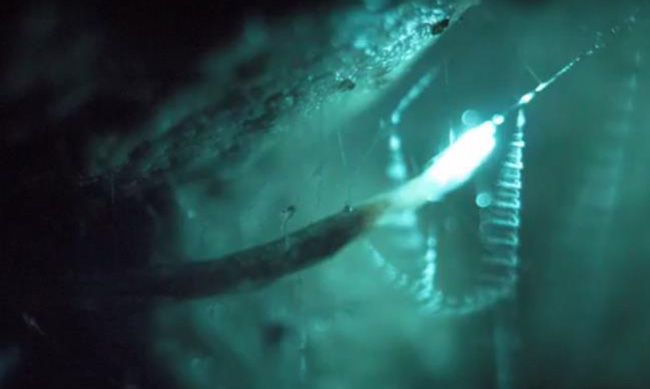
The University of Otago Departments of Biochemistry and Chemistry glowworm bioluminescence research was recently showcased internationally on a US public radio website.
A striking short video Science Friday- Shedding Light on the New Zealand Glow Worm featuring research led by Dr Miriam Sharpe and Professor Kurt Krause was released on the Science Friday show website last week.
The video presents stunning views of Dunedin's local glowworm population and some of the researchers' investigations carried out on these carnivores, which use their light produced in their tails to attract prey.
Dr Sharpe says she is interested in production of light by glowworms (which technically are fly larval gnats), and the proteins that catalyse and control this bioluminescence. The biochemical processes involved are different to those that fireflies use to glow.
Dr Sharpe and Professor Krause worked with Biochemistry and Chemistry PhD student Oliver Watkins and University of Otago Chemistry Professor Nigel Perry to show that the small molecule luciferin, acted on by these proteins, in New Zealand glowworms is very different to the corresponding components which light up US fireflies.
By investigating the structures and mechanisms of action of these proteins and luciferin, Dr Sharpe hopes to develop new bioluminescent biotechnological tools.
For instance, the light-generating proteins that makes glowworms' tails light up could potentially be used in research into cancer drug developments.
Dr Sharpe said glowworms use a different chemistry to make light than other light-emitting creatures. Some of these species, such as fireflies, are already used to provide light for scientific experiments. However, the different chemistry of the glowworms means their light could potentially be used in new ways.
In 2015, Dr Sharpe and colleagues sequenced the first transcriptome of the glowworm, and a differential analysis of expression from the glowworm light organ compared with non-light organ tissue.
Her work has been supported by the former Foundation for Research Science and Innovation (now the New Zealand Ministry for Business, Innovation and Employment), and the Marsden Fund of New Zealand and Dr Watkins' research was supported by a PhD Scholarship from the University of Otago.
Dr Sharpe and colleagues are also investigating the Japanese firefly squid, which uses crystals to make intense blue light to distract its predators.
A list of Otago experts available for media comment is available elsewhere on this website.
Electronic addresses (including email accounts, instant messaging services, or telephone accounts) published on this page are for the sole purpose of contact with the individuals concerned, in their capacity as officers, employees or students of the University of Otago, or their respective organisation. Publication of any such electronic address is not to be taken as consent to receive unsolicited commercial electronic messages by the address holder.
